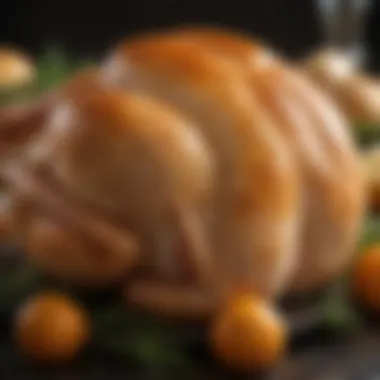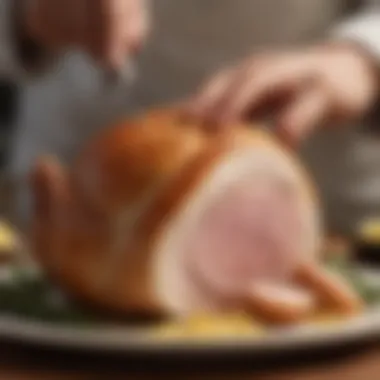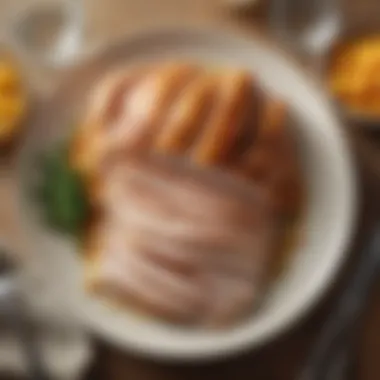Mastering the Art of Roasting Butterball Turkey Breast


Intro
Roasting a Butterball turkey breast can be an enjoyable and fulfilling endeavor. This dish stands out due to its flavor and simplicity, making it appealing for both novice and seasoned cooks. Understanding not only the technical steps, but also the nuances of ensuring optimal tenderness and taste elevates the roasting process.
This guide aims to streamline your approach toward this celebrated dish. It explores ingredients, preparation techniques, and cooking tips that align well with a busy schedule. You'll discover how to enhance each element, making the art of roasting a rewarding experience.
Recipe Overview
- Dish Name: Perfectly Roasted Butterball Turkey Breast
- Yield: Serves 4
- Total Time: 1 hour 30 minutes prep and cook time
- Difficulty Level: Easy
Main Ingredients
- 1 Butterball turkey breast (about 3-4 pounds)
- 2 tablespoons olive oil
- Salt and pepper to taste
- Fresh rosemary or thyme
- Garlic (optional)
Step-by-Step Instructions
Preparing the Ingredients
- Thawing: If your turkey breast is frozen, ensure it is fully thawed. The best method is to place it in the refrigerator for 24 hours prior to cooking.
- Seasoning: In a small bowl, combine olive oil with salt, pepper, and chopped fresh herbs. If you prefer a garlic flavor, mash a couple of cloves into the mix.
- Prepping the Turkey: Pat the turkey breast dry with paper towels. This step helps to achieve a crispy skin. Rub the seasoned oil all over the breast, ensuring it is well-coated.
Cooking the Dish
- Preheat the oven to 350°F (175°C).
- Positioning the Turkey: Place the turkey breast on a rack in a roasting pan to catch drippings.
- Roast Time: Cook for approximately 20 minutes per pound. Check for doneness using a meat thermometer, which should read 165°F (74°C) at the thickest part of the breast.
- Resting: Let the turkey breast rest for at least 15 minutes before carving to retain its juices.
Time-Saving Strategies
- Marinate overnight for added flavor.
- Utilize a convection oven for faster cooking.
Nutritional Information
- Calories per Portion: Approx. 290 kcal
- Proteins: 48g
- Fats: 12g
- Carbohydrates: 0g
Highlighting nutrient benefits, turkey breast is a rich source of protein, low in fat and carbohydrates, making it a healthy option.
Quick Cooking Tips
- Consider boiling the turkey carcass afterward for a flavorful stock.
- Use a slow cooker if you prefer a hands-off approach. It can help maintain moisture.
- For a quicker alternative to roasting, try poaching the turkey breast simmering it in water or broth.
Related Recipes & Variations
- Gravy: Complement the turkey with a traditional homemade gravy.
- Stuffing: Consider stuffing mushrooms with herbs and breadcrumbs for a unique side.
- Easy Salad: Pair with a light arugula salad dressed with a simple vinaigrette.
Adaptations may include gluten-free stuffing or vegetarian options if needed. Inspiring variations can motivate experimentation, making cooking more lively. Share your creations to join in culinary discussions.
Cooking is a form of expression. Adapt any recipe to fit your taste and style.
Be sure to check online cooking forums or social avenues like Reddit and forums on Facebook for diverse take on the recipe from fellow food enthusiasts.
Understanding Butterball Turkey Breast
Understanding the Butterball turkey breast is a vital aspect of mastering the roasting process. Butterball is a well-known brand noted for its high-quality poultry products. Clearly knowing what Butterball turkey breast entails helps ensure optimal cooking results. Before diving into roasting techniques, we must lay the groundwork by detailing what a Butterball turkey breast is and why its nutritional profile is significant.
What is a Butterball Turkey Breast?
A Butterball turkey breast refers specifically to the turkey breast sold under the Butterball brand, distinguished by its tender meat and manageable size. Usually, it comes pre-packaged and sometimes pre-seasoned, which makes it accessible to home cooks. Butterball’s commitment to quality assures the consumer of a consistently high standard, making it a popular choice for holiday meals and other gatherings. It is boneless and skinless, catering to convenience and reducing preparation time. Keeping the ease of cooking in mind can be crucial when working on festive dining.
Nutritional Information
Analyzing the nutritional information of Butterball turkey breast is essential for both health-conscious consumers and culinary enthusiasts. A cooked serving typically contains around 170-190 calories, depending on the exact portion size.
The turkey breast is an excellent source of protein, providing about 35 grams per serving. This quality makes it a favorable option for balanced diets. It is worth noting that turkey breast is also low in fat, often having less than 2 grams per serving, particularly when the skin is removed.
Furthermore, turkey breast offers several vitamins and minerals essential for health, including:
- Vitamin B6 - Important for brain health.
- Niacin - Aids in metabolism.
- Selenium - Plays a role in antioxidant protection.


Understanding these nutritional aspects can guide consumers in crafting healthier meal options while still offering aesthetically pleasing and flavorful dishes.
“The quality of the ingredients impacts the final dish.”
Studying Butterball turkey's importance is essential. As it becomes a focal point on the dining table, knowing its properties allows cooks to enhance their overall strategy in preparing a remarkable meal. By acknowledging what sets Butterball turkey breast apart, readers can appreciate the subtleties involved in its preparation and ultimately achieve delicious results.
Prepping for Roasting
Prepping your Butterball turkey breast is a major step that can directly affect the end result of your dish. The right preparation affects not only the flavor, but also the tenderness and moisture of the turkey. Properly prepping can help ensure that your turkey meets tthe delicious standards you aspise to have. Key elements to consider include thawing, equipment choice, and the type of roasting pan you use.
Thawing the Turkey Breast
Thawing is a critical phase when preparing your turkey breast, directly related to its safety and cooking quality. Butterball turkey breasts are often sold frozen, so it is vital to thaw them safely. The best practice is to plan ahead.
If thawing in the fridge, the rule of thumb is about 24 hours for every 4 to 5 pounds of turkey. This method keeps the turkey at a safe temperature. Alternatively, if you are short on time, you can use the cold water method. Submerge the turkey breast in a sealed plastic bag in cold water, changing the water every 30 minutes. This method typically requires about 30 minutes per pound.
The USDA recommends never thawing a turkey at room temperature to reduce the risk of bacteria growth.
Essential Tools and Equipment
Prepping requires some essential tools. Ensuring you have the right equipment streamlines the roasting process and allows for a more enjoyable cooking experience.
- Roasting Pan: A heavy-duty, sturdy roasting pan is recommended. It evenly distributes heat for better cooking.
- Meat Thermometer: This tool is vital for checking the internal temperature to ensure the turkey reaches the safe zone of 165°F.
- Basting Brush: This helps in keeping the turkey moist during the roasting process.
- Carving Knife and Fork: For slicing the turkey once it’s done, sharp utensils make the task simpler and control superb.
Avoid improvisation with tools; each item serves a particular purpose in ensuring a perfect roast.
Choosing the Right Roasting Pan
The selection of a roasting pan is paramount. An inappropriate pan can lead to uneven cooking or even burnt edges. Consider these factors when choosing:
- Size: Ensure the pan is large enough to accommodate the turkey breast with some space for airflow.
- Material: A heavy-duty metal pan is most recommended. Materials like stainless steel or cast iron conduct heat well and are durable.
- Depth: A deeper pan can help contain juices released by the turkey, which can be used for gravy. Too shallow a pan may result in spills.
Taking time to select the appropriate roasting pan helps to significantly improve your overall cooking experience.
Flavoring the Turkey
Flavoring the turkey is a decisive step towards achieving a memorable and delicious roast. Properly infusing the turkey breast with flavor enhances the meat's natural taste, making it the focal point of the meal. Here is an examination of key elements, benefits, and considerations regarding flavoring a Butterball turkey breast.
Marinades and Brines
Utilizing marinades or brines is an effective strategy to ensure that the turkey is juicy and full of flavor. A marinade typically includes ingredients like oil, acid (such as vinegar or citrus juice), herbs, and sometimes sugar or other flavoring agents. This method allows the flavors to penetrate the meat, resulting in a rich taste profile.
On the other hand, brining is the process of soaking the turkey in a saltwater solution, often spiced or sweetened. This process alters the protein structure of the meat, allowing it to retain moisture during roasting.
Benefits of Marinades and Brines:
- Enhanced Moisture: Keeps the turkey succulent, combating dryness.
- Flavor Depth: Allows for complex flavor profiles that permeate the meat.
- Tenderization: Breaks down tough proteins, resulting in a more tender roast.
Choosing a suitable marinade or brine depends on personal taste. Sweet and spicy combinations work wonders, but equally, simple recipes emphasizing herbs and citrus can showcase the turkey’s natural flavor.
Seasoning Options
Selecting the right seasoning can transform a plain Butterball turkey breast into a tantalizing dish. Seasonings can be as straightforward as salt and pepper or can incorporate complex blends of spices.
Typical Seasoning Ingredients:
- Salt: Essential for flavor enhancement and moisture retention.
- Black Pepper: Provides a mild heat.
- Garlic Powder: Adds depth and a hint of sweetness.
- Paprika: Contributes color and an earthy flavor.
Considering the desired level of heat and a balanced flavor does create consistency in the taste, which is essential for a successful roast. Avoid overwhelming the meat with too many strong spices; simplicity often leads to a well-rounded result.
Herbs and Aromatics
Herbs and aromatics play a significant role in elevating the overall flavor of the Butterball turkey breast. Fresh herbs like rosemary, thyme, and sage add distinctive notes to the roast.
Using Aromatics Wisely:


- Herbs: Freshly chopped herbs can be mixed with butter or oil and rubbed directly onto the turkey's skin. This not only gives it flavor but also presentational appeal.
- Vegetables: Aromatics such as onions, garlic, and celery placed inside the cavity or around the turkey help build a depth of flavor in the roasting environment.
- Citrus: Adding lemon or orange slices can brighten the dish, offsetting richness.
Integrating a balanced selection of herbs and aromatics requires experimentation. Cooking is, after all, an art involving continuous exploration to savor different tastes.
Pro Tip: Preparing an herb butter mix ahead of time and applying it beneath the skin helps to lock moisture and flavor right into the meat.
The Roasting Process
The roasting process is a critical segment in properly preparing a Butterball turkey breast. This stage is where ideal flavors bloom and textures form, a point in time that perfectly captures one’s culinary skills. It is essential to embrace precision by adhering to specific cooking practices to ensure successful roasting. Prioritizing the correct roasting practices enhances the overall experience while avoiding potential pitfalls and elevating flavor.
Setting the Oven Temperature
Setting the right oven temperature is imperative when roasting a turkey breast. For a Butterball turkey breast, preheating your oven to 325°F (about 160°C) is the widely recommended standard. This temperate allows the meat to roast evenly and promotes a well-cooked breast without charring the outer surface. If your oven has variances, consider using an oven thermometer to confirm accuracy.
An important nuance to keep in mind is that regardless of the manufacturer, each turkey breast may cook at slightly different rates. Professionals advocate placing the turkey breast into a preheated oven. Thus, maintaining an optimal roasting environment prevents struggles and promotes juicy meat.
Roasting Times and Temperatures
The cooking time for a Butterball turkey breast generally depends on its size. A gallon of guidance states about absent election of 1.5 to 2 hours for a 4 to 8-pound turkey breast. Always reference Turkey Breast's thawed time not to dry out the meat. To guarantee that you achieve thorough cooking, consider placing the turkey breast in the oven before family demands arise. Positioning the turkey as focused elements like expanding on the flavors can grant peace of an undisturbed moment later on.
While roasting, note these ranges:
- 4 lb - Approximately 2 - 2.5 hours
- 6 lb - Approximately 2.5 - 3 hours
- 8 lb - Approximately 3 - 3.5 hours
Meat should reach an internal temperature of 165°F. Following clear instructions can support a positive outcome in creating a gentle texture.
Basting Techniques
Basting helps improve moisture and contributes to the complexity of flavors formed on your turkey breast. Professional chefs express the importance of timely basting; every 30 to 45 minutes can yield a favorable flavor composition. This method should involve broth, butter, or a mixture of chosen seasonings being applied with a brush or baster through an open oven's two-doored experience.
Efficient basting involves the following:
- Resistance is key: Avoid leaving the oven closed too long.
- Light hand: Get just enough liquid to develop without sogginess lingering upon established exterior.
- Combine method: Some peppers can atomize solid fines and allow flavors to marry under your commitment.
Basting actively maintains a layer of flavors, ultimately keeping the turkey moist and inviting.
Using a Meat Thermometer
A meat thermometer is one of the most important tools you can utilize in ensuring your Butterball turkey breast is not only cooked but safe to consume. The dialogue emphasizes checking the thickest part of the breast, but avoid pressing the meat against bones as such areas will result in an inaccurate reading. The tipping scale defines cooking can't continue under 165°F, marking assured quality and safety.
Using a meat thermometer involves the following strategy:
- Insert the probe carefully.
- Verify the recorded temperature in parts.
- Take note: Remove from the oven well cooked progress within a slightly invested margin gives you the appropriated moments possible barrel and errors.
Keeping to precise techniques spotlighting intentional purpose inspires control through each facet of the process.
Post-Roasting Considerations
Post-roasting considerations are essential to the overall success of your Butterball turkey breast. This phase is just as important as the preparation and roasting process itself. Skipping these steps can lead to disappointing results.
Resting the turkey allows the juices to redistribute throughout the meat. When removed from the oven, the proteins in the turkey breast are tight. Allowing it to rest allows these proteins to relax, thus preventing the juices from oozing out upon carving. Overall, proper resting contributes to a moist end product.
Furthermore, carving techniques help ensure that the turkey is presented attractively. A well-carved turkey not only looks appealing on the plate but also facilitates serving. This chapter addresses how to effectively rest and carve your turkey, which are crucial for maximizing flavor and enjoyment.
Resting the Turkey
Resting the turkey breast after roasting is a step that requires attention. Removing the turkey from the oven doesn't mark the end of the cooking process; it contains crucial moments that influence flavor and moisture retention. Ideally, you should let the turkey breast rest for 20 to 30 minutes before carving. This holding period is an opportunity for juices to settle within the meat.
To rest adequately:
- Cover the turkey loosely with aluminum foil to keep it warm.
- Avoid tight wrapping, as that can generate steam, which may lead to a soggy skin.
The temperature inside the meat will continue to rise slightly. An estimated increase of 5 to 10 degrees Fahrenheit during resting can bring the internal temperature closer to the optimal level for safety and texture.
Carving the Turkey


Carving the turkey breast is an art that highlights both aesthetics and practicality. A clean cut not only adds visual appeal but also ensures serveable pieces. To carve effectively:
- Place the turkey breast on a cutting board, breast side up.
- Use a sharp carving knife to make the first incision against the side of the breastbone, cutting downward alongside the bone.
- Once you reach the bottom of the breast, lift the slice to reveal more of the meat for subsequent cuts.
- Continue until all slices are even and manageable for serving.
Carve with care, maintain the integrity of each piece, and preserve the moisture for better flavor. Knowing how to carve the turkey lets you serve everyone easily and keeps the meat portioned evenly. As with resting, this step is a pivotal conversion of a well-prepared turkey to a memorable meal experience.
Always remember, a properly rested and well-carved turkey ensures a joyful dining occasion.
Serving Suggestions
Serving suggestions play a pivotal role in elevating your Butterball turkey breast experience from mere sustenance to a memorable feast. After you have intricately roasted this culinary centerpiece, the presentation and accompanying flavors showcase your thoughtful preparation. A well-considered pairing doesn’t merely fill plates; it harmonizes each element, enriching your meal through complementary textures and flavors.
Pairing with Side Dishes
Selecting the right side dishes can significantly enhance your turkey breast. Here are some effective options that balance out the flavor profile:
- Mashed Potatoes: Rich, creamy mashed potatoes offer comfort. The buttery smoothness complements the turkey's tenderness.
- Green Beans: Fresh or sautéed green beans add a crisp contrast. Their slight bitterness refreshes the palate after savory turkey bites.
- Stuffing or Dressing: This classic addition provides a hearty, savory component with its herby nature.
- Cranberry Sauce: The sweet-tart briskness cuts through richness, engendering a dynamic mouthfeel. The acidity meets the turkey tastefully.
- Roasted Root Vegetables: Carrots, parsnips, and sweet potatoes, when roasted, develop caramelization that deepens flavors.
Each pairing has its unique traits. It is wise to think about balance. Pairing rich dishes with things that provide freshness or acidity is a common practice.
Creating Leftover Meals
Turkey leftovers can be a culinary canvas. Proper storage helps keep the meat succulent. Develop new meals inspired by the original:
- Turkey Sandwiches: Layer slices with lettuce and herbs on crusty bread or rolls. Adding slices of ripe avocado offers creaminess.
- Turkey Soup: Use excess carcass for broth. Include leftover turkey pieces, vegetables, and pasta. A warming option for any day.
- Enchiladas: Mix shredded turkey with cheese and vegetables in corn tortillas. An overlay of sauce adds flavor, and bake until bubbly.
- Turkey Salad: Combine cold turkey with herbs, diced apples, or dried cranberries. Creamy dressings magnify texture while keeping it light.
Thinking creatively about leftovers expands the meal’s possibilities. Take the time to plan, and you can minimize waste while exploring new tastes.
Great meals extend gratitude to ingredients—aim for versatility and nuance, particularly with leftovers.
Troubleshooting Common Issues
Addressing challenges is essential when preparing a Butterball turkey breast. Understanding common issues increases the chances of a successful roast. Being informed helps you anticipate problems that may arise. This section serves as a guide to manage situations that could lead to an unsatisfactory meal. Each subsection delves into specific problems and their solutions.
Dry Turkey Breast
A dry turkey breast is often the result of overcooking. Moisture is key during cooking, and losing it can lead to disappointing textures and flavors.
Causes:
- Long roasting times: If left in the oven too long, the meat can lose its natural juices.
- High oven temperatures: A temperature that's too hot can speed up the cooking while making moisture escape quickly.
Prevention and Solutions:
- Use a meat thermometer: This tool is crucial. Cooking until the internal temperature reaches 165°F helps retain moisture.
- Basting: Regularly apply some of the pan juices on the turkey during cooking. This adds moisture back to the meat.
- Resting time: Allow the turkey to rest for at least 20 minutes after roasting. This permits the juices to equalize within the meat. Avoiding cut into the turkey too soon minimizes moisture loss.
Undercooked Portions
The threat of undercooked turkey is serious, as it could pose food safety risk. A thorough approach is critical in avoiding this problem.
Causes:
- Non-uniform size: Any unevenness in the turkey breast can result in areas cooking at different rates.
- Inaccurate temperature measurement: Sometimes, the oven may not show the true temperature, leading to problems.
Prevention and Solutions:
- Cut size evenly: If you choose to split the breast, make cuts that are similar in size. This leads to even cooking results.
- Meat thermometer use: This is essential. It ensures all parts of the turkey have reached at least 165°F. You can check the thicker areas to confirm safety.
- Tent with foil: If you've discovered parts undercooked after carving, you can reroute cooking by tenting with foil and returning to the oven for a short time. Be sure to keep checking temperatures regularly.
This highlights the need for attention to detail during cooking. By staying informed, you can resolve common problems with relative ease while roasting.
Ending
Roasting a Butterball turkey breast is an endeavor that merits attention, particularly when approaching festive gatherings or family meals. Understanding the intricacies involved ensures that both the preparation and the final results are delightful.
By mastering key techniques outlined in this article, whether it’s selecting appropriate seasonings or implementing effective cooking methods, culinary enthusiasts can elevate their turkey dish into a centerpiece worth celebrating. The benefits stretch beyond taste; they include food presentation and the joy of satisfying shared meals.
Considerations such as the importance of resting the turkey emphasize patience in allowing flavors to develop fully. Proper carving techniques play a significant role in showcasing the final dish, ensuring each slice remains tender and inviting.
"The satisfaction of a perfectly roasted turkey breast transcends just a meal; it cultivates memories that linger beyond the table."
In bringing together all these elements, the takeaway from roasting a Butterball turkey breast is the overall experience it creates. Balancing time with flavors, coupled with practical tips, makes the process not just accomplishing but a rewarding one. This guides home cooks through complexity into simple joy, guiding them to achieve both tender meat and an occasion to remember. Remember, it is about more than just eating; it’s about connecting, celebrating, and savoring each bite.







